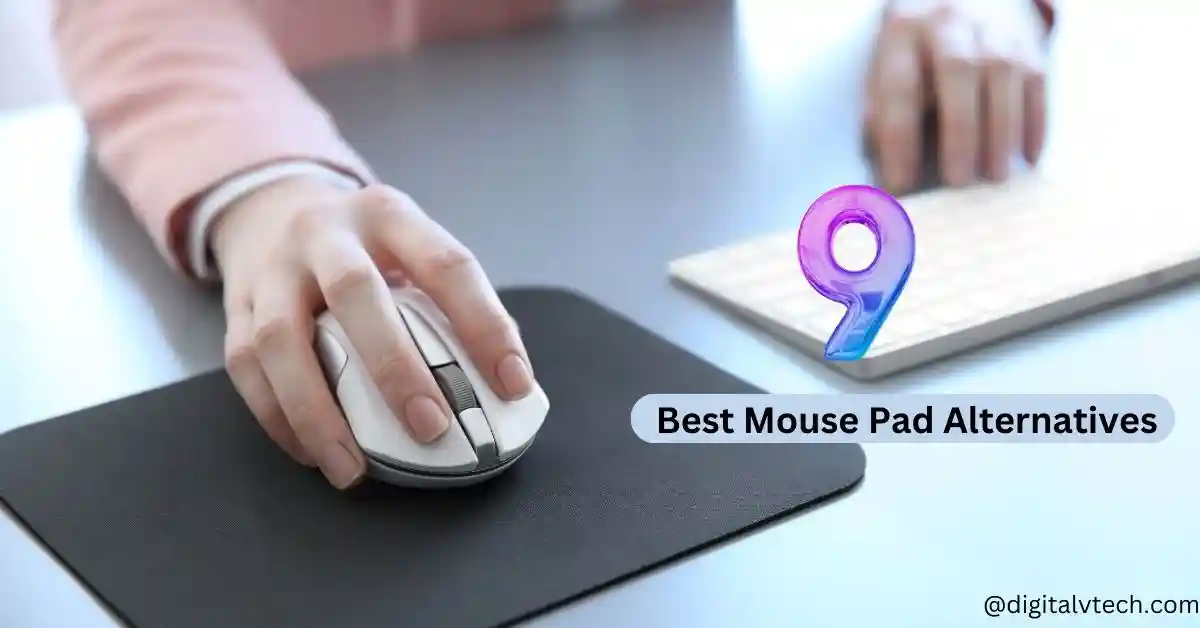When it comes to gaming, having the right equipment is crucial for an immersive and smooth experience. While a mouse pad is commonly used to enhance mouse precision and control, there are situations where you might find yourself without one.
Whether you’re traveling, at a friend’s place, or simply looking for a budget-friendly solution, several alternatives can substitute for a traditional mouse pad. Here in this article, we will provide a list of nine of the best mouse pad alternatives for gaming, offering you options that are both convenient and effective.
Why Is It Important To Have A Mouse Pad Or Any Alternatives?
Having a mouse pad or suitable alternatives is important for several reasons:
- Precision and Control: A mouse pad or mouse pad alternatives provide a consistent and smooth surface for your mouse, allowing for precise movements and control. It helps in reducing friction, ensuring that your mouse glides smoothly across the surface without any erratic or jumpy movements. This is especially crucial for gaming, where accurate mouse control is essential for aiming, tracking targets, and executing precise movements.
- Improved Tracking: A good mouse pad offers enhanced tracking capabilities, particularly for optical and laser mice. The surface of a mouse pad is designed to optimize the sensor’s performance, allowing it to interpret and respond to your movements accurately. This results in smoother cursor movements and improved responsiveness during gaming sessions.
- Durability and Protection: Mouse pads are built to withstand the constant friction and wear caused by mouse movement. By using a dedicated mouse pad or suitable alternatives, you protect your desk or other surfaces from scratches, scuffs, and wear caused by the mouse’s contact. It helps maintain the longevity of both your mouse and the surface it operates on.
- Consistent Gaming Experience: Using a mouse pad ensures a consistent gaming experience regardless of the surface you are playing on. Different surfaces can impact mouse movement differently, leading to variations in sensitivity and accuracy. A mouse pad provides a standardized surface, eliminating the uncertainties and inconsistencies that may arise when using alternative surfaces.
- Ergonomics and Comfort: Mouse pads often come with ergonomic designs that prioritize user comfort. They provide a cushioned surface that supports your wrist and forearm during long gaming sessions, reducing the risk of discomfort, fatigue, or repetitive strain injuries. The use of a suitable mouse pad alternative can also offer similar benefits, ensuring a comfortable and ergonomic gaming experience.
- Aesthetics and Personalization: Mouse pads come in various designs, patterns, and sizes, allowing you to personalize your gaming setup. They can complement your gaming peripherals, add a touch of style, or even showcase your favorite game or artwork. While alternative options may not offer the same level of customization, they can still provide a visually appealing and personalized touch to your gaming environment.
9 Best Mouse Pad Alternatives:
Desk Surface:

The most readily available mouse pad alternative is simply using your desk surface. Most modern gaming mice can track accurately on various surfaces, including wood, glass, or plastic. However, it’s important to ensure that your desk is clean and free from scratches, as rough or uneven surfaces may affect mouse movement and accuracy.
Hardcover Books:
If you’re in a pinch, a stack of hardcover books can serve as a temporary mouse pad. By placing a flat book or a stack of books beneath your mouse, you create a smooth surface with sufficient stability for accurate mouse tracking. Be sure to choose books with sturdy covers to avoid excessive movement.
Magazine or Newspaper:
A magazine or newspaper can provide a makeshift mouse pad solution. By placing it under your mouse, you can achieve a smoother surface for improved tracking. While this alternative might not offer the same precision as a dedicated mouse pad, it can work well in a casual gaming environment.
Writing Pad:
A writing pad or notepad can be repurposed as a mouse pad substitute. These pads typically have a smooth surface, making them suitable for mouse movement. Opt for a larger-sized pad to ensure ample space for unrestricted mouse motions.
Drawing Tablet:
If you happen to own a drawing tablet, its smooth and responsive surface can double as a mouse pad. Drawing tablets are designed to provide accurate input for digital art, making them ideal for precise mouse movements during gaming sessions.
Whiteboard or Glass Surface:
Whiteboards or glass surfaces, such as a glass table or a glass panel, can be excellent alternatives to traditional mouse pads. These surfaces offer minimal friction and allow for smooth gliding of the mouse, ensuring precise tracking. However, be cautious of reflective surfaces that may interfere with optical mouse sensors.
Rubber or Neoprene Mat:
If you have a rubber or neoprene mat lying around, it can be repurposed as a temporary mouse pad. These materials offer sufficient traction and can provide a stable surface for accurate mouse control. Look for a clean and flat mat for optimal performance.
Gaming Mouse Feet:
Many gaming mice feature replaceable feet, which are typically made of smooth Teflon material. In the absence of a mouse pad, the Teflon feet can be used to achieve improved glide and control on your desk surface. However, this alternative might not be as effective as using a dedicated mouse pad.
DIY Cloth Mouse Pad:
If you’re feeling crafty, you can create your own mouse pad using a cloth material, such as denim or felt. Cut the material to the desired size, and attach a non-slip rubber or foam backing to prevent it from sliding. This DIY mouse pad can offer a soft and comfortable surface for precise mouse control.
Things to Consider while purchasing a Mouse Pad
Before getting a mouse pad, there are a few key factors to consider to ensure that you choose the right one for your needs. Here are some important considerations:
- Size and Surface Area: Mouse pads come in various sizes, ranging from small to extra-large. Consider the available space on your desk and your preferred mouse movement range. If you require ample space for sweeping mouse movements, a larger mouse pad might be suitable. However, if you have limited desk space or prefer precise and quick movements, a smaller pad could be a better fit.
- Material and Surface Texture: Mouse pads are typically made from materials like cloth, hard plastic, glass, or hybrid surfaces. Each material offers different characteristics. Cloth mouse pads provide a soft and comfortable surface with good control, while hard plastic or hybrid surfaces offer faster glide and minimal friction. Consider your preference for speed, control, and comfort when choosing the material and surface texture of the mouse pad.
- Gaming Style: Different gaming genres have distinct requirements. For example, first-person shooters (FPS) demand precise and quick movements, while real-time strategy (RTS) games may benefit from larger pads for expansive mouse movements. Consider the gaming style you engage in most frequently and choose a mouse pad that suits your specific gaming needs.
- Mouse Sensor Compatibility: Some high-end gaming mice come with advanced sensors that can track accurately on a wide range of surfaces, while others may perform optimally on specific types of pads. Check if your mouse has any specific recommendations regarding the type of mouse pad it works best with or if it supports tracking on different surfaces.
- Thickness and Stability: Mouse pads vary in thickness, with thinner ones providing a lower profile and thicker ones offering more cushioning. Thicker pads can provide wrist support and comfort during long gaming sessions, but they might elevate your wrist to a less ergonomic position. Additionally, ensure that the mouse pad has a non-slip base or an anti-skid backing to prevent unwanted movement during intense gameplay.
- Cleaning and Maintenance: Consider the ease of cleaning and maintaining the mouse pad. Cloth pads are generally machine washable, while hard plastic or hybrid surfaces may require wiping with a damp cloth. Opt for a mouse pad that can be easily cleaned to maintain its performance and longevity.
- Budget: Set a budget for your mouse pad purchase. Prices can vary depending on the size, material, and brand. Determine how much you are willing to spend and find a balance between your requirements and budget.
- Reviews and Recommendations: Before making a final decision, read reviews and seek recommendations from other gamers. Their experiences and feedback can provide valuable insights into the performance, durability, and overall quality of different mouse pads.
Conclusion:
While a mouse pad is a valuable accessory for gaming, there are numerous alternatives available that can deliver satisfactory results. Whether it’s using your desk surface, repurposing household items, or getting creative with DIY solutions, these alternatives ensure you can enjoy smooth mouse movements and accurate tracking during your gaming sessions. Experiment with different options to find the one that suits your preferences and enhances your gaming experience, even without a traditional mouse pad.
You may also read:
Things That You Should Consider Before Buying A Gaming Mouse










